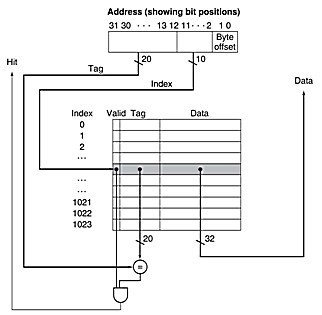The figure shows a direct-mapped cache structure where
|

|
- Index
- It is used to select the block. A block is the minimum unit of information that can be either present or not present in a cache. Because the cache has 210 (or 1024) blocks and a block size of one word, 10 bits are used to index the cache.
- Tag
-
The tag from the cache is compared against the upper portion of the address to determine whether the entry in the cache corresponds to the requested address.
Because 10 bits are used to index the cache and 2 bits are for the
offsetfield, leave32-10-2=20bits to be compared against the tag. - Offset
- It is used to select the byte address in a block. This field is 2 bits for this cache because it has blocks with a size of 1 word (or 4=22 bytes).
|
I just finished my last exam. Let’s go out and paint the town red! (go out drinking and partying). |